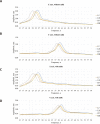Effect of low frequency oscillations during milking on udder temperature and welfare of dairy cows
- PMID: 37093951
- PMCID: PMC10119468
- DOI: 10.5187/jast.2022.e74
Effect of low frequency oscillations during milking on udder temperature and welfare of dairy cows
Abstract
The study aimed to investigate the effect of low-frequency oscillations on the cow udder, milk parameters, and animal welfare during the automated milking process. The study's objective was to investigate the impact of low-frequency oscillations on the udder and teats' blood circulation by creating a mathematical model of mammary glands, using milkers and vibrators to analyze the theoretical dynamics of oscillations. The mechanical vibration device developed and tested in the study was mounted on a DeLaval automatic milking machine, which excited the udder with low-frequency oscillations, allowing the analysis of input parameters (temperature, oscillation amplitude) and using feedback data, changing the device parameters such as vibration frequency and duration. The experimental study was performed using an artificial cow's udder model with and without milk and a DeLaval milking machine, exciting the model with low-frequency harmonic oscillations (frequency range 15-60 Hz, vibration amplitude 2-5 mm). The investigation in vitro applying low-frequency of the vibration system's first-order frequencies in lateral (X) direction showed the low-frequency values of 23.5-26.5 Hz (effective frequency of the simulation analysis was 25.0 Hz). The tested values of the first-order frequency of the vibration system in the vertical (Y) direction were 37.5-41.5 Hz (effective frequency of the simulation analysis was 41.0 Hz), with higher amplitude and lower vibration damping. During in vivo experiments, while milking, the vibrator was inducing mechanical milking-similar vibrations in the udder. The vibrations were spreading to the entire udder and caused physiotherapeutic effects such as activated physiological processes and increased udder base temperature by 0.57°C (p < 0.001), thus increasing blood flow in the udder. Used low-frequency vibrations did not significantly affect milk yield, milk composition, milk quality indicators, and animal welfare. The investigation results showed that applying low-frequency vibration on a cow udder during automatic milking is a non-invasive, efficient method to stimulate blood circulation in the udder and improve teat and udder health without changing milk quality and production. Further studies will be carried out in the following research phase on clinical and subclinical mastitis cows.
Keywords: Animal welfare; Low-frequency vibrations; Milk parameters.
© Copyright 2023 Korean Society of Animal Science and Technology.
Conflict of interest statement
No potential conflict of interest relevant to this article was reported.
Figures







Similar articles
-
Effects of feeding level, milking frequency, and single injection of cabergoline on feed intake, milk yield, milk leakage, and clinical udder characteristics during dry-off in dairy cows.J Dairy Sci. 2021 Oct;104(10):11108-11125. doi: 10.3168/jds.2021-20289. Epub 2021 Jul 16. J Dairy Sci. 2021. PMID: 34275624
-
Effects of simulated quarter and udder teat cup removal settings on strip milk and milking duration in dairy cows.J Dairy Sci. 2020 May;103(5):4446-4454. doi: 10.3168/jds.2019-17266. Epub 2020 Feb 26. J Dairy Sci. 2020. PMID: 32113765
-
Invited review: udder health of dairy cows in automatic milking.J Dairy Sci. 2011 Feb;94(2):547-62. doi: 10.3168/jds.2010-3556. J Dairy Sci. 2011. PMID: 21257025 Review.
-
The effect of 2 different premilking stimulation regimens, with and without manual forestripping, on teat tissue condition and milking performance in Holstein dairy cows milked 3 times daily.J Dairy Sci. 2020 Oct;103(10):9548-9560. doi: 10.3168/jds.2020-18551. Epub 2020 Aug 20. J Dairy Sci. 2020. PMID: 32828498
-
Dry-off and dairy cow udder health and welfare: Effects of different milk cessation methods.Vet J. 2020 Aug;262:105503. doi: 10.1016/j.tvjl.2020.105503. Epub 2020 Jul 5. Vet J. 2020. PMID: 32792097 Review.
References
-
- McClure SR, Merritt DK. Extracorporeal shock-wave therapy for equine musculoskeletal disorders [Internet] Compendium. 2003. [[cited 2022 May 7]]. http://assets.prod.vetlearn.com.s3.amazonaws.com/mmah/a2/47cf6e30a24ac1a... .
LinkOut - more resources
Full Text Sources

